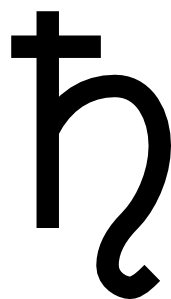The word "planet" comes from the Greek meaning wanderer. There are 8 planets and at least five dwarf planets in our solar system. In astrology, each planet has its own personality and affect on individuals and societies based on its location in an astrological chart.
Planets were first recorded and studied in ancient Babylon and the oldest surviving astronomical text is the Venus tablet of Ammisaduqa written in the 7th century BCE. The Enuma anu enlil, written during the Neo Assyrian period of the 7th century BCE details various omens, including the movements of the planets and what they presaged. This, and similar ideas, may be the roots of modern astrology. At this time, only five planets were as yet identified.
For the purposes of astrology, the moon and sun are also identified as planets although they are more properly referred to as luminaries.
Ceres -Discovered on January 1 1801, by Giuseppe Piazzi, Ceres is the smallest dwarf planet in our Solar System. It is named after the Roman mother and grain Goddess, Ceres.
Earth -The planet Earth, also called by its Latin name Terra, is the only planet in our solar system known to support life. It is the third planet from the Sun and the fifth largest. It is also the densest of all of the planets in our solar system.
Mars -Mars is the ruling planet of Aries and, before the discovery of Pluto, it was universally considered the ruler of Scorpio. Most modern astrologers consider Pluto the ruler of Scorpio, but many regard Mars as a co-ruler, while all traditional astrologers still regard Mars as the only ruler of Scorpio.
Mercury -Mercury is the planet closest to the sun in our solar system. It is also the smallest planet in the solar system, assuming you accept Pluto's recent demotion to dwarf planet. Mercury orbits the sun once every 88 days. It is bright, but difficult to see because of its proximity to the sun. Look for it in the morning and evening twilight.
Moon -The Moon is a natural satellite that orbits the Earth from about 238,856 miles (384,402km) away. It is among the largest moons in our solar system, relative to the size of the planet it orbits and its gravitational force can be felt here on Earth, affecting ocean tides, and according to many folkways, the body systems of plants and animals as well. The moon makes a complete orbit around the Earth every 27.3 days and because it rotates on its axis at about the same speed it orbits the Earth, the same part of the moon is always visible to us. The different phases that we see are due to the angle at which the Sun illuminates the Moon. When the moon is dark, the Sun is illuminating the "dark side" of the moon and the side facing us is dark. When the moon is full, the sun is on the opposite side of the Earth from the moon. If the Earth gets between the moon and sun during this time, we have a lunar eclipse. Although the Sun is roughly 400x bigger than the Moon, they appear to be about the same size in the sky because the Sun is also 400x farther away; this makes it possible for the moon to almost entirely obscure the sun during a solar eclipse.
|
Table of Contents
|
Neptune -Neptune is the eighth furthest planet from the sun in our solar system, the fourth largest in diameter and the third most massive. The planet is named after the Roman God of the Sea, Neptune.
Pluto -Pluto was discovered in 1930 and named by an 11 year old girl named Venetia Burney. Until 2006, Pluto was considered the 9th planet from the sun (although this isn't always the case as its rotation sometimes brings it closer to the sun than Neptune). In 2006, however, astronomers reclassified Pluto as a dwarf planet. This doesn't stop most astrologers from continuing to view Pluto as the ruling planet of Scorpio.
Saturn -

1Saturn is the ruling planet of Capricorn and, traditionally, Aquarius. In Roman lore Saturn was the god of agriculture founder of civilizations and of social order and conformity. The glyph is most often seen as scythe-like but it is primarily known as the "crescent below the cross", whereas Jupiter's glyph is the "crescent above the cross". The famous rings of the planet Saturn that enclose and surround it, reflect this principle of man's limitations. Saturn takes 29.5 years to orbit the sun, spending about 2.46 years in each sign of the zodiac.
Sun -The sun is the center of and the largest object in our solar system. It contains more than 99% of the total mass of our solar system. It is 1,390,000 km in diameter and has a mass of 1.989e30 kg. The temperature of the sun is 5800K on the surface and 15,600,000K at the core. It is made up mostly of hydrogen and helium.
Venus -The Planet Venus has been given many names throughout history. It has been called the evening and the morning star, the dawn star, Eosphorus, Hesperus and Lucifer. It is the planet closest to Earth and has been called Earth's sister planet, even her twin. It is easily seen in the sky in the evening and morning and is the brightest "star" in the heavens. It was second only to the sun and the moon in significance by the reckoning of many ancient cultures.
See Also
Do you have any questions or something to add?
Note: This is not an appropriate place for very personal information or spell requests. They will be deleted.
You can Print this page for your Book of Shadows



